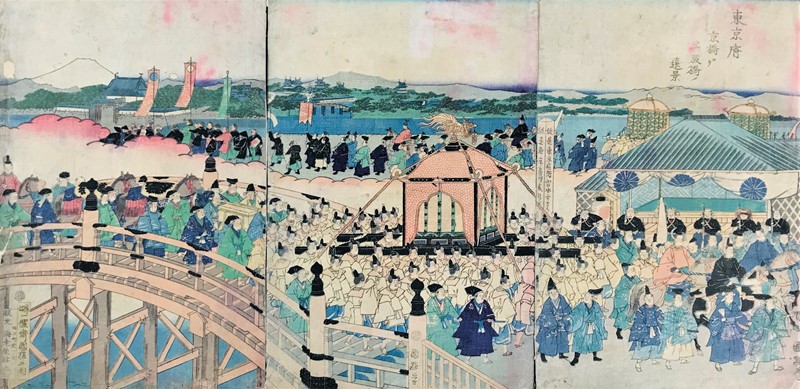
149
KUNITERU II. Emperor Meiji enters Tokyo. Triptych.
EUR 600,00
Base d'asta
EUR 1.200,00 / 1.500,00
Stima
Descrizione
KUNITERU II. Emperor Meiji enters Tokyo. Triptych.
Utagawa KUNITERU II.
1830-1874
Tokyo-fu Kyobashi yori Gofukubashi no enkei.
Emperor Meiji enters Tokyo. The procession crossing the Kyobashi Bridge. Triptych.
Late November 1868
Polychrome woodcut, altogether 350x710 mm, trimmed within margins. Title at the top right. Each sheet with the artist's signature on the bottom “Kuniteru ga”. Above the signature the censor seal “aratame”, with the zodiacal year sign on the top right, and the month on the bottom right. Censor seal: Dragon Year, 11 mounth (1868, November). Defects, good copy.
Condition Report
Very rare print, depicting the Emperor's entrance to Tokyo in November 1868. Soon after his coronation, the Emperor journeyed to Tokyo by road, visiting it for the first time. He arrived in late November. During the journeys, the emperor was seated in a horen, a litter the emperor was supposed to ride on travels out of the palace. Regarding iconography, Fujitani writes: “In keeping with the emperor’s actual invisibility in the procession, however, this print and others depicting the Eastern Progress (Tokyo), such as Ichiyokusai Kuniteru’s …, did not display the emperor’s physical body. Instead, they suggest the presence of a powerful but visually absent body by focusing on the magnificent imperial palanquin with its blinds pulled down. This is especially true of Kuniteru’s print: the imposing imperial palanquin, carried by a mass of men, is placed prominently in the scene’s foreground, imperial body unseen, while in the background we can the former Edo Castle, just recently renamed Tokyo-jo, to which the imperial body is presumably be carried and hidden away again. The emphasis on the palanquin over the body is particularly remarkable if we are to accept the British diplomat Ernest Satow’s word that the emperor was carried in a smaller and far less conspicuous enclosed chair, an itagoshi, and not the horen.” Only one specimen found in the Kanagawa Museum, described by Fujitani, which publishes the photograph with the legend: “Figure 17. Woodblock print of the Meji Emporor’s entry into Tokyo in November 1868. The imperial palanquin is crossing over the bridge at Kyobashi. Ichiyokusai Kuniteru, “Tokyo-fu Kyobashi yori Gofukubashi no enkei”, 1868. Courtesy of Kanagawa Prefectural Museum of Cultural History.”
Utagawa Kuniteru II, ?? ??(??), (1830-1874) was born Yamada Kunijiro in Edo (Tokyo) and was a print designer, painter and book illustrator. He studied under Utagawa Kunisada I. He produced yakusha-e (actor pictures), bijinga (beautiful women pictures), fuzokuga (pictures of manors and customs), meisho-e (pictures of famous places) sumo-e (pictures of wrestlers), educational prints and, most famously, bunmei kaika-e (pictures of modernization) in a late Utagawa-school manner. He was known by various names. Before 1844 he may also have been known as Sadashige ?? and signed works with the name Ichiyusai. He changed his name in 1865 to Kuniteru II.
Bibliografia
See F. Fujitani, Splendid Monarchy, Power and Pageantry in Modern Japan, University of California Press, 1998. 198-199.
gio 15 Ottobre 2020
Orari Asta
Palazzo Del Capitanio
Via dei Soncin, 25
info@badoemart.it
www.badoemart.it
PADOVA
Sabato 10 10-18
Domenica 11 10-18
Lunedi 12 10-18
Martedi 13 10-18

